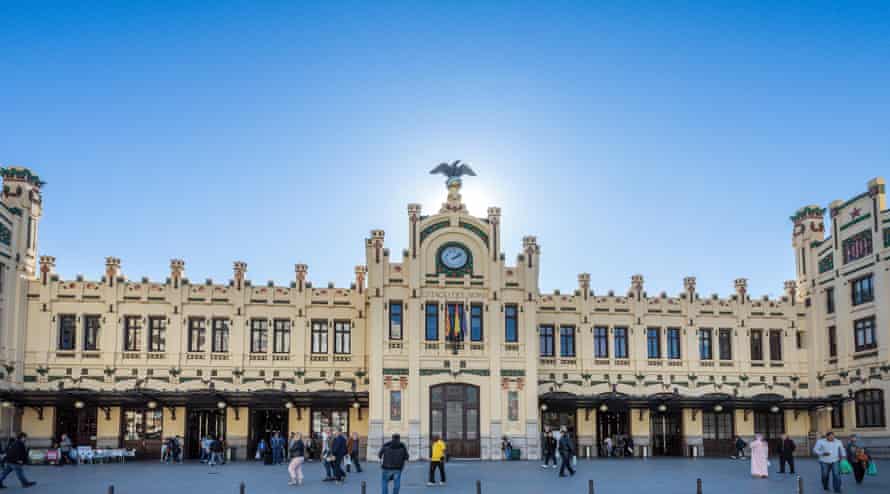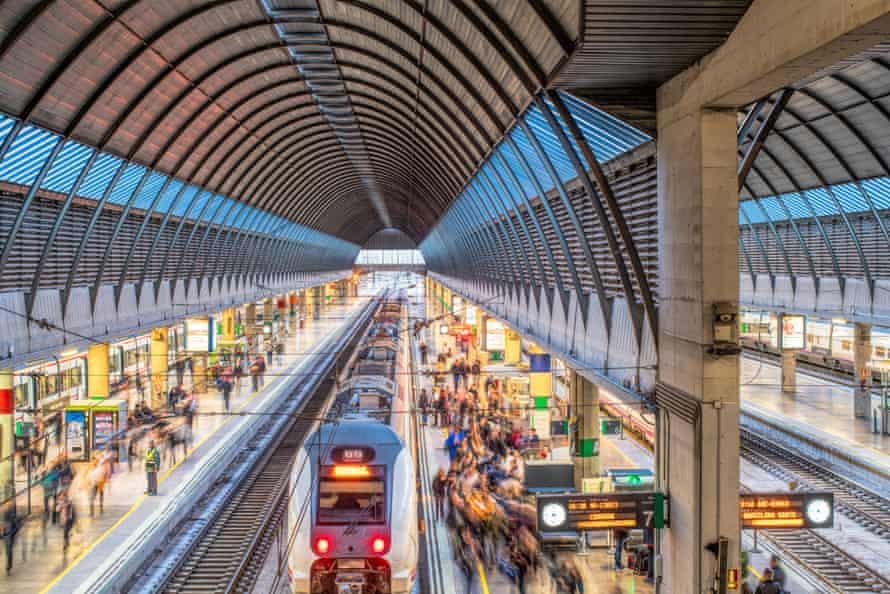
Two long-distance trains leave Barcelona Sants station just after nine each morning. There’s the French TGV to Paris, 668 miles and almost seven hours to the north. The other train, much the more interesting of the two, is the 09.05 to Cádiz, a journey of 12 hours, covering 800 miles. This is one of Spain’s finest domestic train journeys, a great cross-country transect linking the Mediterranean coast of Catalonia with the Atlantic shores of Andalucía. The train manager on the four-carriage train to Cádiz captures it rather nicely when she says: “Welcome to the fast train to nowhere and the slow train to everywhere.”
The beauty of this dawdling journey across Spain is that it honours distance and landscapes. Despite a couple of short, high-speed stretches, the train to Cádiz generally doesn’t hurry. There’s a meditative appeal in making a long journey through a litany of changing landscapes. When did you last have 12 hours to yourself? There’s time to think, just daydream and gaze out of the window. Along the way it swaps Catalonia’s restrained charm for the fiery warmth and sensual appeal of the Spanish south. Remember Byron’s The Girl of Cadiz, who was “born beneath a brighter sun”.
Our train rolls out from the subterranean depths of Sants station into soft Catalan sunshine, and soon we are weaving through Barcelona’s suburbs. An amble turns into a dash, as we follow a fast line out of the city, looping well inland of Tarragona and only regaining the coast over an hour into the journey.
Windmills, almonds and art nouveau
The 09.05 to Andalucía is a Spanish legend. It’s called Torre del Oro (Golden Tower), taking its name from the striking Almohad-era watchtower and prison by the River Guadalquivir in Seville.
Thirty years ago this month, Spain’s first high-speed railway opened, slicing through the Sierra Morena to connect Madrid and Andalucía. With the development of more high-speed routes, few of Spain’s slower long-distance trains have survived. But the Torre del Oro has shown great staying power, and follows broadly the same route as 30 years ago. There have been tweaks here and there, and for many years it did not run beyond Seville. Happily, the full route from Barcelona through to Cádiz was reinstated last summer. For a spell, the train was called García Lorca, after the radical poet and playwright, but in 2014 its name reverted to Torre del Oro. That switch was perhaps prompted by the dropping of through carriages to Lorca’s adopted home town of Granada.
A quick glance at a map suggests that the ride south from Barcelona to Valencia runs mainly along the Levante coast. It’s actually far more varied than that. We cross the beautiful wetlands of the Ebro delta, then turn inland of the Serra del Montsià, with carob trees and rich groves of olives and almonds. Just after midday we pull into Valencia’s Estació del Nord, a few minutes early, so there’s time to take a peek at the station’s gorgeous art nouveau facade.
Then it’s back on the Torre del Oro for a slow ride west through increasingly arid terrain to Alcázar de San Juan, with some fine La Mancha windmills on the way. This is Don Quixote country, and Cervantes was well disposed towards La Mancha. Others less so, like Richard Ford, whose 1845 Handbook for Travellers in Spain is an enduring classic of travel literature. “A wide expanse of monotonous steppes, over which nought but a genius like Cervantes could have thrown any charm,” Ford wrote. La Mancha isn’t so bad, and there’s plenty of greenery in the vineyards as we ride south through Valdepeñas.

Despeñaperros is the highlight of the journey and the gateway to Andalucía. If you buy into Ford’s dim view of La Mancha then the stretch of railway through the Despeñaperros gorge really is like swapping a desert for an Eden. Might this be the rocky wilderness imagined in the third act of Bizet’s Carmen, where, amid a chorus warning of the dangers of the journey, José and Escamillo fight over our heroine?
Sherry and smugglers
Bizet’s smugglers and the banditti who lent colour to early travelogues are long gone. Despeñaperros has been tamed, but it’s nonetheless impressive. Passing through the gorge, we are trading in the aridity of La Mancha for lush colours and the landscapes of Velázquez and Murillo. The train to Cádiz pauses at Vilches, its blue and white station a cooling contrast to the warm September sunshine. The fragrant smells of the south waft in through the open doors of the train. Soon we are on our way again, huge oleanders by the tracks as we drop down towards the Guadalquivir Valley, which we follow south-west through Córdoba to Seville.
Santa Justa railway station in Seville is gracious and stylish, as befits the southern terminus of Spain’s first high-speed railway. It was the Seville Expo in 1992 which acted as catalyst for that new railway. Today one can speed from Barcelona to Seville in five-and-a-half hours. My slow train has taken almost twice that.

But this is not yet the end of the line for the Torre del Oro, so I stay on board for the final leg to the coast at Cádiz. We keep up a steady pace to Jerez, the town that gave its name to sherry. With the sun dipping lower in the west, it’s a glorious evening as the train slips quietly through the salt pans that mark the approach to the port city of Cádiz. It is almost dark as we pull into the station. I am one of just a handful of passengers who have stuck with the Torre del Oro to the end.
Book well in advance and you can ride the Torre del Oro all the way from Barcelona to Cádiz for as little as €30. If booked just a week prior to travel, expect to pay about €50 second class or €60 first class. Book through renfe.com. Interrail passes are valid, with a small mandatory charge for a seat reservation.
Nicky Gardner is co-author of Europe by Rail: the Definitive Guide. The 17th edition of the book is published this month and is available at a discount via the Guardian Bookshop



